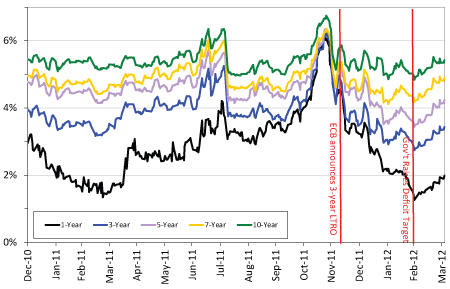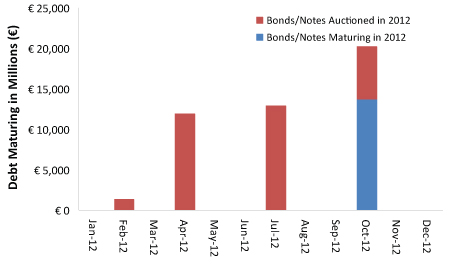Personal Wealth Management / Economics
The Pain in Spain?
Entering 2012, sentiment toward Spain and Italy (the two non-bailed out PIIGS) was notably dour—likely influenced by debt and deficit fears along with sharply rising bond yields in late 2011. But in our view, this dampened expectations—meaning even ok results from the countries’ 2012 debt auctions would likely exceed most folks’ diminished expectations. And on balance, through the first three months of the year, that seems to have been the case. (Especially so with Italy.)
Through Q1, Spanish debt auctions largely met their target volumes, with ample coverage—much more successful than dire euro-doom prognostications. However, Spain’s had a bit less stunning success of late—and held a more tepid auction on Wednesday, spurring concern. The auction raised €2.6 billion (at the lower end of the target volume range) at higher rates and with much weaker coverage than even two weeks ago. Yields on three-year bonds, the bulk of the auction, jumped from 2.44% to 2.89%.
But one mediocre auction needn’t necessarily spell disaster for Spain. Although yields on Spanish benchmark bonds ticked up following a revised budget deficit target in early March, they’re still measurably below 2011’s peaks. (See Exhibit 1.) Perhaps more importantly, Spain has already rolled over 76% of its maturing longer-term bonds this year—in some ways, the greater hurdle to overcome. (See Exhibit 2.) Shorter-term bills are typically easier to roll over and those are still at lower yields.
That’s not to say Spain is completely out of the woods this year—although, in our view, the possibility of a looming bailout is being blown out of proportion. Recent budget consternations of hitting deficit targets likely have contributed to investor unease—probably heightened Wednesday as Spain released its 2012 budget plan, which cited increased total 2012 debt issuance of €186 billion. This shouldn’t be a surprise to many, given the country’s ongoing budget deficits. (However, under the plan, net issuance of longer-term bonds amounts to only about €36 billion.) This increases Spain’s debt-to-GDP ratio to 79.8%. Higher isn’t ideal, but that’s still well below the average eurozone debt-to-GDP of 90.4% and simply isn’t an alarming level, globally speaking.
Although the ECB’s LTRO programs likely provide Spain with some additional time to work through the country’s issues, reality is, the ECB didn’t exactly wave a magic wand. It bought time for reform, and reform is no easy or smooth road. To that end, it’s likely Spain continues to muddle through a series of difficult austerity measures and pro-growth reforms. Prime Minister Mariano Rajoy and his government have every incentive to push these measures through. And although there’s evidence Spain is making progress, it should be expected there will be bumps in the road along the way—which Wednesday’s auction seems to exemplify well.
Exhibit 1: Benchmark Spanish Sovereign Yields (Since 12/31/2010)
Source: Thomson Reuters, as of 04/03/2012.
Exhibit 2: Maturing Spanish Bonds / Notes This Year
Source: Bloomberg, as of 03/15/2012.
If you would like to contact the editors responsible for this article, please message MarketMinder directly.
*The content contained in this article represents only the opinions and viewpoints of the Fisher Investments editorial staff.
Get a weekly roundup of our market insights
Sign up for our weekly e-mail newsletter.

You Imagine Your Future. We Help You Get There.
Are you ready to start your journey to a better financial future?

Where Might the Market Go Next?
Confidently tackle the market’s ups and downs with independent research and analysis that tells you where we think stocks are headed—and why.







